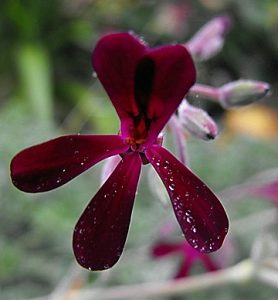 In simple terms plants are classified in order of family, genus and species. Pelargonium sidoides DC is from the family of flowering plants Geraniaceae. Pelargonium is one genus and the family name is derived from another genus, Geranium. Pelargonium sidoides DC was first documented by the Swiss botanist Augustin Pyramus de Candolle in 1824 hence the author abbreviation DC after the species name.
In simple terms plants are classified in order of family, genus and species. Pelargonium sidoides DC is from the family of flowering plants Geraniaceae. Pelargonium is one genus and the family name is derived from another genus, Geranium. Pelargonium sidoides DC was first documented by the Swiss botanist Augustin Pyramus de Candolle in 1824 hence the author abbreviation DC after the species name.
P. sidoides is a perennial native flowering plant of the Eastern Cape Province of South Africa and the adjacent Lesotho highlands. It is known as the South African geranium. Its flowers have five maroon/dark red to nearly black petals, two of which are sometimes fused. The leaves of the plant are heart-shaped and velvety with silver-grey edges.
The tuberous roots form rhizomes which are bright red when cut in cross section. Ethanol is used to extract the active ingredients from the roots to make the herbal medicines.

A very closely related plant, Pelargonium reniforme CURT, has historically been confused with P. sidoides. It contains many of the same constituents in the root as P. sidoides and is included in some Pelargonium extracts and is included in the European Pharmacopoeia monograph. P. reniforme differs from P. sidoides visually having flowers that are magenta with two distinctive stripes on the upper two petals, more plain green leaves and roots that appear more yellow on the outside. P. reniforme grows in a more restricted geographic area than P. sidoides.
The phytochemistry of the Pelargonium species is further detailed elsewhere on this site.